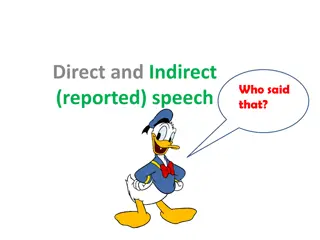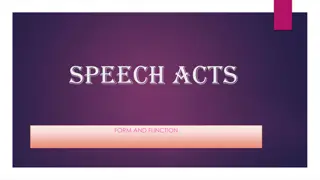Guide to Writing an Information Speech
Learn how to write an information speech by determining the purpose, gathering supporting material, organizing the content, and creating a structured outline. Follow the steps provided to craft an effective and informative speech on any topic.
Download Presentation

Please find below an Image/Link to download the presentation.
The content on the website is provided AS IS for your information and personal use only. It may not be sold, licensed, or shared on other websites without obtaining consent from the author. Download presentation by click this link. If you encounter any issues during the download, it is possible that the publisher has removed the file from their server.
E N D
Presentation Transcript
INFORMATION SPEECH How to write the information speech
1. DETERMINE THE PURPOSE The speech should have a stated Specific Purpose (what you want to speech to accomplish): Specific Purpose o Informative example Informative example: to identify the three key points on which students and administrators disagree about increasing resident tuition.
2. GATHER SUPPORTING MATTERIAL Supporting Material Supporting Material Illustrates the main points by clarifying, elaborating and verifying the speakers ideas. Definition the dictionary meaning of a word; give a source Illustration a personal story that helps to further clarify the idea or point Example a specific representation of a group or type Statistic a numeric collection of data; give a source Analogy a comparison of two liked things Quote to cite someone s statement or thoughts; give a source Restatement to restate the main idea of the topic
3. ORGANIZE THE SUPPORTING MATTERIAL As you gather the supporting material, divide it into SUBTOPICS OR CATEGORIES. Then arrange the categories in an order that makes sense. This becomes the order of the main points. chronological pattern topical pattern climactic pattern (bang-bing-boom) cause-effect pattern (persuasion speeches) problem-solution pattern (persuasion speeches)
4. WRITE THE OUTLINE Prepare an outline Prepare an outline (due 1 week prior) (due 1 week prior) III. Conclusion I. Introduction A. Review main points (#1, #2, #3) B. Final Punch C. Thank you A. Attention Getter B. Purpose C. Preview II. Body A. Main Point #1 B. Main Point #2 internal summary C. Main Point #3 Full-Sentence Outline of main points, sub-points, and sub-sub- points *include source citations within the *include source citations within the outline outline
Example Outline Topic Topic: Organizational Organizational Pattern: Pattern: Speech Speech Purpose Purpose: The toothbrush Topical To inform my audience about the toothbrush Specific Specific Speech Speech Purpose Purpose: To inform my audience about the origin and history of the toothbrush, the different types of toothbrushes, and the correct way to use the toothbrush. 3 main points
I. INTRODUCTION A. (As I under-handedly toss new and sealed toothbrushes into the audience while saying catch .) Can you name one thing that was invented in ancient Roman times that we still use every day of our lives? (Toss toothbrush.) Did you know that during fifteenth century China, the hog was used for more than just food? (Toss) Is there any way that we can listen to the Billboard Top 40 in the bathroom without having to setup a radio? (Toss) The answer is simple: it all goes back to the toothbrush. Each day, we wake up in the morning, eat breakfast, and then brush our teeth. After dinner, as we re getting ready for bed, we brush our teeth again, but why? Is it really that important or can we just skip it if we re too tired? Sometimes we re too busy or it s just too much of a hassle. B. Perhaps if we develop a deeper understanding as to why we perform this seemingly mundane task brushing our teeth, each day, we ll be less likely to take it for granted. C. So, today I will be informing you about the toothbrush by first explaining the origin of the toothbrush, secondly, discussing the way the toothbrush came into the modern era, and third, explaining the different types of toothbrushes. HOOK PURPOSE PREVIEW
II. BODY 9 A. Origin of the toothbrush A. Origin of the toothbrush 1. The original form of oral hygiene was known as a toothstick. a) This device was invented in ancient Rome, a civilization that implored special slaves whose sole purpose was to clean the teeth of their masters teeth b) In ancient civilizations, oral hygiene was an extremely private matter, and researchers believe that slaves were killed due to discussing their masters toothstick usage with others.
II. BODY B. The toothbrush enters the modern era 1. The original toothbrush was invented in China in 1498. The handle was bamboo or bone and the bristles were course hairs taken from the back of a hog s neck. (Show visual aid #1) 2. The toothbrush soon became a symbol of wealth. The more extravagant your toothbrush was, the more financially sound you were within your society. (Show visual aid #2) 3. The first toothbrush was patented in 1857, in Europe, and the item was a household product before the turn of the century. a) The invention and patent of the toothbrush paved the way for the American Dental Association and the American Association of Dental Schools. b) The invention of the toothbrush also lead to other oral hygiene related practices such as orthodontics, periodontics and even toothpaste.
II. BODY INTERNAL SUMMARY I ve told you about the origin of the toothbrush and how the toothbrush came into the modern era. Now you will hear the different types of toothbrushes so you can correctly chose the best one for you!
II. BODY C. Types of toothbrushes available 1. The electric toothbrush a) All bristles are made of nylon because it is a strong synthetic fiber. b) Co. like Sonicare and OralB have created toothbrushes that have the capacity to play downloaded songs, which act as a timer to ensure that the users brush for the recommended two minute time frame. 2. The manual toothbrush a) The soft bristle brush i. Geared toward children and the elderly as they tend to have more sensitive gums. ii. The soft bristles will help prevent bleeding when brushing. b) The medium bristle brush i. Recommended by dentists because the bristles have the necessary flexibility, but are sturdy enough to help reduce plaque buildup and remove bacteria. ii. most commonly recommended bristle strength that dentists recommend c). The strong bristle brush i. For the patient with severe dental needs, but is not usually recommended as it can cause bleeding. ii. Bleeding leads to open sores within the mouth, which becomes a breeding ground for bacteria.
III. CONCLUSION Today, I have informed you about the origin of the toothbrush, explained how the toothbrush came into the modern era, and third, gave examples of different types of toothbrushes available. The toothbrush was first invented nearly 3,000 years ago. This is one of the few inventions that have withstood the test of time and the basic idea and design of the toothbrush has remained constant. So go home and brush like you ve never brushed before, but make sure you use nylon bristles, and not hog s hair. THANK YOU REVIEW MAIN POINTS FINAL PUNCH
5. PREPARE YOUR NOTECARDS 1. Use white index cards. o Make an outline for the body of your speech WITH KEY POINTS. o Write out any transitions (review/previews) 2. Keep in mind that your card is graded for neatness as well as completeness--you can't speak WELL from messy and cluttered notes.
NOTECARD EXAMPLE Topic Topic: The toothbrush BODY: A. ORIGIN INTRO: 1. Toothstick Ask questions hand out brushes Don t take it for granted 1. Origin of toothbrush 2. Modern Era 3. Types of toothbrushes a. slaves clean master s teeth b. private = kill slaves B. MODERN ERA 1. China 1948 Bamboo Bristles = Hogs neck hair (visual aid #1)
NOTECARD EXAMPLE C. CONCLUSION 1. Review a)origin of the toothbrush b) modern era c)different types of toothbrushes B. MODERN ERA 2. symbol of wealth (visual aid #2) 3. patented in 1857 2. Purpose a) 3,000 years ago b) stood the test of time Led to - ortho, perio & toothpaste. INTERNAL SUMMARY I ve told you about the origin of the toothbrush and how the toothbrush came into the modern era. Now you will hear the different types of toothbrushes so you can correctly chose the best one for you! 3. Final Punch nylon bristles-not hog s hair 4. THANK YOU
6. SOURCE CARD a. Turn in 5 3x5 note cards each with complete bibliography of at least 5 published sources (within the last 5 yrs) b. No more than three of the sources can come from the Internet, and all Internet sources should include a complete reference not just a URL address. c. Dictionaries and encyclopedias will only count as ONE source
6. SOURCE CARD Bibliography: Higgins, D.D.S., Holly. Telephone interview. 16 Jan. 2008. Hyson, Jr., D.D.S., M.S., MA, John M. "History of the Toothbrush." Journal of the History of Dentistry 51.2 (2003). Miller, D.D.S., Ronald W. Telephone interview. 13 Jan. 2008. Sherman, Kimberly. Telephone interview. 21 Jan. 2008. "Who Invented the Toothbrush." Everyday Mysteries. 4 Apr. 2007. Library of Congress. 12 Jan. 2008 <http://www.loc.gov>. Woolston, Chris. "Brushing and Flossing." A Healthy Me 30 July 2006
VISUAL AIDS 1 1. . Visual aids should be used to enhance Visual aids should be used to enhance the explanation of the topic. It is not to take the place of information. Should be well prepared and incorporated into the speech. 2. Ask yourself these questions about your visual aid 2. Ask yourself these questions about your visual aid o Is the visual aid accurate and contains NO spelling / fact errors, and is it up to date? o Can the audience see the aid easily from the back of the room? o Is the information neat with adequate spacing and contrasting colors? o Is the visual aid SIMPLE and not cluttered with too many details?
VISUAL AIDS TYPES OF VISUAL AIDS TYPES OF VISUAL AIDS Physical objects, props and models White boards Charts and posters Flip charts Overhead transparencies Computer presentations, e.g. PowerPoint Movies (YouTube / dvd)
Practice Delivering the Speech PRACTICE, PRACTICE, PRACTICE!! Success depends on preparation, even for a short speech. Suggestion: A good speech is practiced at least 6 times. Like an actor, you are delivering your lines. You will want to feel and appear natural to your audience.
Practice Delivering the Speech Vocal Delivery: Vocal Delivery: Volume Rate Pitch Variety Pronunciation Articulation Nonverbal Delivery : Nonverbal Delivery : Facial expressions Gestures General body movement Overall physical appearance
PROFESSIONAL DRESS ATTIRE DO s DO s . . Solid Colors/Neutral or Subdued Colors Conservative outfits Dark dress pants/white or light colored shirt Women Light/natural-looking make-up and minimal Overall good hygiene (a clean, polished appearance)
PROFESSIONAL DRESS ATTIRE DON TS . DON TS . Tattoos (cover if possible) Hair that hangs in the face and/or has to be repeatedly fixed and/or covers eyes Women . No Heavy perfume, Low-cut tops, Sheer blouses or skirts, Crop shirts, Sleeveless/halter tops and NO Big/bold/excessive jewelry Men . Wrinkled/Un-Ironed shirts, Baggy and/or low-hanging pants, Facial hair, Heavy cologne Hats/caps Tennis shoes/boots/sandals/hiking shoes/ Flip-flop, thong, platform shoes No gum or candy


![Prevention and Combating of Hate Crimes and Hate Speech Bill [B.9B.2018]](/thumb/60513/prevention-and-combating-of-hate-crimes-and-hate-speech-bill-b-9b-2018.jpg)




















